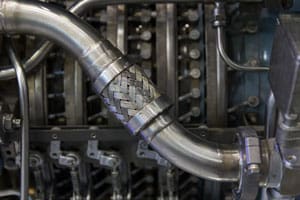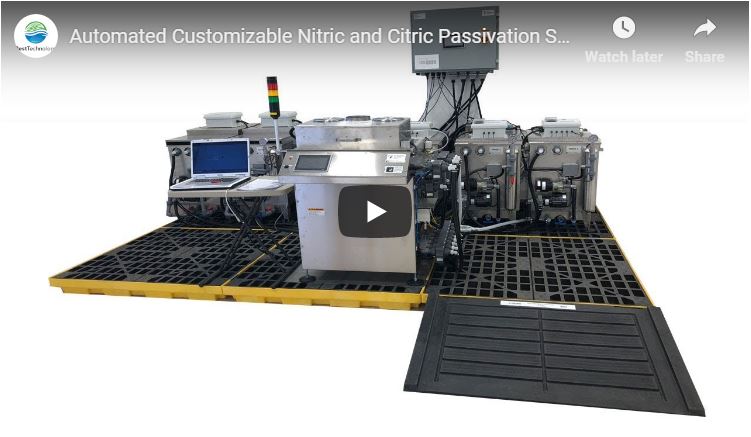Nitric vs Citric Acid Passivation: What’s the Difference?
 Many people ask about the differences between nitric acid and citric acid for passivating parts made of stainless steel (SS), titanium (Ti), and other alloys. So what is the difference between nitric vs. citric passivation? Compared to the nitric acid method of passivating, citric acid passivation is:
Many people ask about the differences between nitric acid and citric acid for passivating parts made of stainless steel (SS), titanium (Ti), and other alloys. So what is the difference between nitric vs. citric passivation? Compared to the nitric acid method of passivating, citric acid passivation is:
- Newer – Began to be adopted in the 1990s
- More environmentally friendly – No nitrogen oxide vapors (NOx) that contribute to smog and acid rain and affect the ozone layer of the atmosphere
- Safer – Non-hazardous material requires no special handling or regulatory oversight and does not corrode other equipment.
Passivating Stainless Steel
Both nitric acid and citric acid are effective in passivating many grades of stainless steel, and both methods are described in detail in the industry standards ASTM A967 and AMS 2700.
In the 1960s, the U.S. military defined the first specifications for passivation using nitric acid on stainless steel in the QQ-P-35 standard. Over time, however, the environmental and safety hazards of using nitric acid became more apparent. The quest for an effective, safer alternative was fulfilled with the use of citric acid passivation, which began to be adopted in the 1990s.
Industry standards for citric passivation first came to the aerospace industry, where the QQ-P-35 standard became the AMS-QQ-P-35, which was later replaced by the AMS 2700 standard in the early 2000s. For other industries such as medical device, the industry standard ASTM A967 replaced the old QQ-P-35 standard in 2005.
Since both of the most-used standards derived from the QQ-P-35 military standard of the 1960s, questions often arise about the differences between ASTM A967 vs. AMS 2700. These standards are essentially equivalent, and differ by who uses them. The aerospace industry tends to use AMS 2700, while other industries use ASTM A967.
Today both nitric acid and citric acid are widely-used, industry-accepted methods of passivation of stainless steel.
Passivating Titanium
What if you need to passivate titanium? Since titanium alloys do not contain iron, they technically do not need a passivation treatment to form a passive metal oxide layer. However, if titanium parts may have been contaminated with iron during manufacturing processes, that iron could become rust if it is not removed. The process of removing iron from the surface of titanium is essentially identical to that of passivating stainless steel, so the term passivating titanium is often applied.
While it is possible to passivate titanium with citric acid, the passivation of titanium is more typically governed by ASTM F86, which only specifies nitric acid, and not citric acid.
Nitric Acid Passivation
Nitric acid passivation is the traditional method of removing free iron from the surface of stainless steel, titanium and other metals for corrosion prevention.
As the legacy method of passivation, nitric acid on stainless steel offers the advantage of a proven, established process. For those committed to using nitric passivation, a variety of options exist to optimize performance with the particular grade of stainless steel.
Less corrosion-resistant grades of stainless steels have a greater risk of etching, also known as flash attack, during passivation in nitric acid. To reduce that risk, the following approaches may be used:
- Addition of sodium dichromate to the nitric acid
- Higher nitric acid concentration
- Higher temperature of nitric acid.
Note that even though these options reduce the risk of etching, they do increase the risks to worker safety associated with hazardous chemicals. Sodium dichromate is a hexavalent chromium compound, and a known carcinogen.
Options for Nitric Acid Passivation in ASTM A967
| Type | Chemistry | Temperature | Time | Best For |
| Nitric 1 | 20 – 25% nitric acid by volume, 2.5% +/- 0.5% sodium dichromate by weight |
120 – 130 °F | 20 min. minimum |
|
| Nitric 2 | 20 – 45% nitric acid by volume | 70 – 90 °F | 30 min. minimum |
|
| Nitric 3 |
20 – 25% nitric acid by volume |
120 – 140 °F | 20 min. minimum |
|
| Nitric 4 | 45 – 55% nitric acid by volume | 120 – 130 °F | 30 min. minimum |
|
| Nitric 5 | Other combinations of temperature, time, nitric acid concentration and other chemicals that produce parts that pass test requirements in ASTM A967. | |||
Nitric acid itself is a hazardous chemical that emits toxic and corrosive fumes, and therefore requires special attention to ventilation and safe chemical handling. Though not a known carcinogen, nitric acid can cause severe chemical burns rapidly. When released in the atmosphere, nitric acid emissions contribute to acid rain and smog, and can affect the ozone layer. All of this explains why the industrial use of nitric acid is highly regulated, with stringent requirements for worker safety and environmental protection.
Citric Acid Passivation
Citric acid passivation offers a safer, more environmentally friendly alternative to nitric acid passivation. Citric acid is an organic acid that comes from citrus fruits like oranges, and as such is safe for employees to handle. Fumes from citric acid are not toxic and not harmful to the atmosphere. Citric passivation meets all current industry standards, and is effective with nearly all grades of stainless steel.
In the past, some manufacturers avoided citric acid due to potential organic growth and molding issues. Today, citric acid has improved with new formulations for biocides which prevent organic growth in solution. These new advancements have allowed smaller manufacturers which had little to no experience with chemical handling to bring their passivation process in-house.
Citric passivation vs. nitric passivation also offers shorter cycle times. Parts can be processed in as little as 4 minutes when using citric acid, compared to 20 minutes minimum with nitric acid.
As with nitric acid, it is important to maintain a balance between temperature, immersion time and acid concentration with citric acid passivation, to avoid the challenges of runaway corrosion known as flash attack.
Options for Citric Acid Passivation in ASTM A967
| Type | Chemistry | Temperature | Time |
| Citric 1 | 4 – 10% citric acid by weight* | 140 – 160 °F | 4 min. minimum |
| Citric 2 | 4 – 10% citric acid by weight | 120 – 140 °F | 10 min. minimum |
| Citric 3 | 4 – 10% citric acid by weight | 70 – 120 °F | 20 min. minimum |
| Citric 4 | Other combinations of temperature, time, citric acid concentration and other chemicals that produce parts that pass test requirements in ASTM A967. | ||
| Citric 5 | Same as Citric 4, except the pH of the immersion bath must be maintained in the range of 1.8 – 2.2. | ||
*Note that the citric acid percentage is measured by weight, while the nitric acid percentage is measured by volume.
For more details on citric passivation, please see our page on citric acid passivation. Learn more about citric acid material compatibility with our CitriSurf® Compatibility Guide for various grades of stainless steel.
The following chart provides a summary of the key differences between nitric vs citric passivation.
Comparison Summary: Nitric vs Citric Passivation
Nitric Acid |
Citric Acid |
|
| Safety | Hazardous handling required | Very safe to use as directed |
| Air breathing | Emits toxic and corrosive gases | No toxic and corrosive gases emitted |
| Ease of use | Chemical handling safety equipment and extreme care required for most use | Minimum chemical handling safety equipment required |
| Passivation | Excellent passivation of most grades of stainless steel | Excellent passivation of nearly all grades of stainless steel |
| Environment | Environmentally hazardous | Environmentally friendly |
| Cost |
|
|
| Passivation process duration | 20 minutes to several hours | 5-20 minutes typical |
| Process temperature |
|
|
| Chemical process maintenance | Regular solution monitoring required (titration) | Regular solution monitoring required (specific gravity) |
| Iron oxide removal | Slowly removes iron oxides | Readily removes iron oxides |
| Equipment | Long-term corrosive degradation of non-stainless steel metal or polymer-based equipment or components | No corrosive degradation of equipment |
| Process stability | Must control time and temperature closely as danger of nitric oxide gas exists – proper ventilation required | Less prone to time and temperature variation, no hazardous vapors |
| ASTM A967 | Meets requirements | Meets requirements |
| AMS 2700 | Meets requirements | Meets requirements |
| ASTM A380 | Meets requirements as referenced in ASTM A967 | Meets requirements as referenced in ASTM A967 |
| AMS QQ-P-35 | Meets requirements as referenced to AMS 2700 and ASTM A967 | Now referenced to AMS 2700 and ASTM A967 |
To learn more about nitric vs citric passivation industry standards and specifications, please see our page "What is Passivation?"
Today, many companies are taking a second look at citric acid due to its ease of chemical handling, disposal and overall safety for employees, all of which are more challenging when going with nitric acid passivation vs citric acid passivation. Best Technology works closely with many companies in the aerospace and medical device industries and has successfully assisted these companies with converting from nitric to citric acid. Often it is as simple as talking with the end customer and showing them the equivalency of the types of passivation.
Video: Automated Customizable Nitric and Citric Passivation System
Need BOTH nitric AND citric acid passivation? This system can handle it all. This 3-in-1 system offers 3 different automated passivation options:
- Nitric acid
- Nitric acid with sodium dichromate
- Citric acid.
A key advantage of an automated passivation system is that it is designed to run as a closed-loop system, so the operator is not exposed to chemicals like nitric acid.
Equipment for Nitric Acid Passivation
Best Technology is a recognized industry leader in passivation equipment, systems, tanks and lines. Our automated passivation equipment is particularly well-suited for nitric acid passivation, due to reduced worker interaction with hazardous chemicals. Whether it's citric acid or nitric acid passivation, Best Technology can provide a system that's right for your company.
Types of passivation equipment
- Small benchtop passivation equipment
- Wet bench passivation equipment
- Automated passivation systems
- Agitated immersion passivation systems
Except as noted, each of these types of passivation equipment can be built for use with either citric acid or nitric acid. The nitric acid systems do require additional ventilation in the system design, so it’s important to understand which chemistry you’ll be using when specifying passivation equipment.
CitriSurf® is a registered trademark of Stellar Solutions, Inc. McHenry IL USA.
Consult an expert
Need advice on nitric vs citric passivation, or planning your passivation line? Exploring making the move from nitric acid to citric acid? We can help. Contact a passivation expert at Best Technology to learn more.

